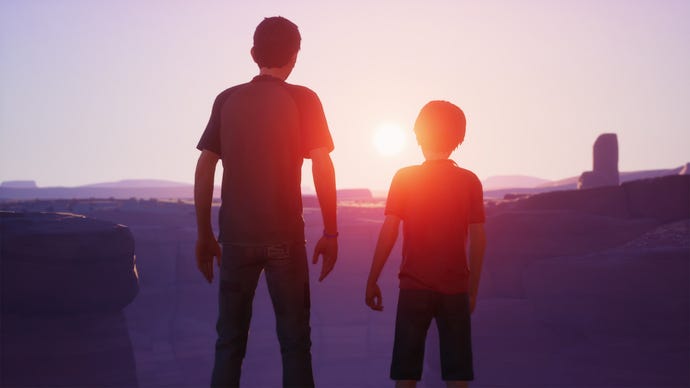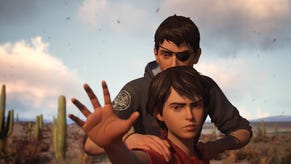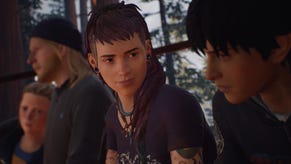Life Is Strange 2 Series Review: Brothers, A Tale of Two Wolves
Life Is Strange's sequel has wrapped up, so our journey with Sean and Daniel has come to an end.
This article first appeared on USgamer, a partner publication of VG247. Some content, such as this article, has been migrated to VG247 for posterity after USgamer's closure - but it has not been edited or further vetted by the VG247 team.
Oh, Sean and Daniel, I wanted better for you. Not just in spirit, but for a game. Sean and Daniel Diaz are the brothers at the forefront of Life Is Strange 2, a sequel that carries onward Degrassi-like portrayals of the strifes of youth and supernatural powers.
Life Is Strange 2, unlike its predecessor, doesn't have you rewinding time and solving a missing persons case though. Instead, it's like any other 3D adventure game where you walk around and make big choices to pull the narrative in a number of directions. In Life Is Strange 2, you're Sean; a teen older brother on the run with his little brother Daniel who happens to have mysterious telekinetic abilities.
The result for the sequel is a game that feels outside of the comfort zone for the developers who made it. Rather than zeroing in on universally relatable issues of bullying, queer love, and suicide, the French developers of Dontnod turn its sights onto very American issues: police brutality, and the very specific type of racism Latinx in the United States face every day. As a result, the cultural distance is sometimes palpable, with Life Is Strange 2 swinging and missing when it's tackling some of our country's most pervasive, normalized issues. It's an earnest attempt to show these nasty, everyday occurrences, even if at times it comes off as a bit corny.
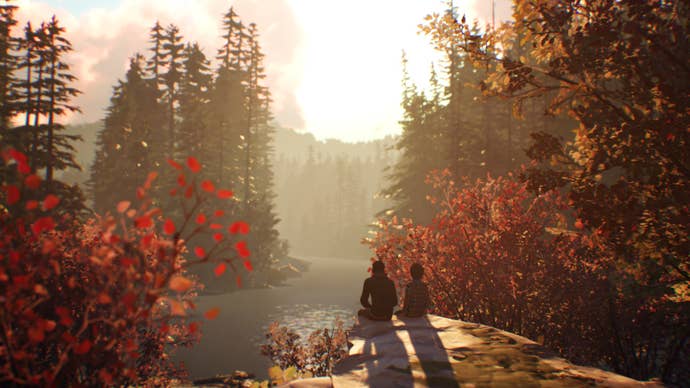
Over the course of five episodes, we follow the two brothers down the West Coast as they befriend strangers and encounter villains in plainclothes. The villains of their story are the sort we see on television every day, or worse, encounter. It's the relative who is watching One America News, or the colleague who complains about Mexicans "stealing jobs." It's the everyday people who hold those nonsensical views and act on them with malice against human beings. These familiar evil forces are aplenty in Life Is Strange 2, and they always pop up at inconvenient times. The repeated incidents become too redundant, like the time racists beat up an already-injured Sean in the middle of the desert despite his "crime" being... sleeping in a car, which was barely off the heels of the last racist encounter he had. These types of run-ins become unfortunately formulaic as the season goes on, shedding any impact it had in the earlygoings.
Life Is Strange 2 is at its best when it's just Sean and Daniel. Talking, exploring, bonding. The two have gone through the worst of ordeals: their father is shot by a trigger-happy cop, and the trauma awakens a dormant telekinetic power within the 9-year-old Daniel. An explosive wave that emerges from Daniel kills the officer. Everyone in the vicinity passes out, but Sean wakes up, picks up Daniel, and gets them out of the Pacific Northwest suburb they live in. They go on the lam.
Nearly every episode operates in a similar way: Sean and Daniel spend time together with no distractions, they talk about how much they love and miss their dad, they encounter a racist person or two, and then they meet someone nice. Sometimes these events are jumbled up, but as the season went on, I came to anticipate where the story would take me. There are very few actual twists and turns along the way. Still, even as I grumbled about the extended detours with one-episode character appearances it failed to make me care for, the thread that pulled me along was wanting to see how Sean and Daniel fared. I wanted to see them make it across the border, or reach some semblance of peace, no matter what it took.
A strength Life Is Strange 2 does have is in the choices you make. A lot of them look and feel minor in the scope of the plot itself, but over the course of its five episodes, you're actually shaping not just Sean, but his little brother Daniel too. Daniel looks up to Sean, and how you treat him reflects on how he grows up. This all factors in for the final choice, which feels minor, but can split into four wild different directions (technically with seven in total, with minor differences)—and it all depends on not just the final choice you make, but how Sean has influenced Daniel too.
It's a fascinating difference compared to the first Life Is Strange, which had choices that were mostly concerned with moving the plot in certain directions, not so much on actually shaping characters. Life Is Strange 2's overall journey might be a less eventful one than its predecessor, but its two leads are the strongest Dontnod's ever done because of how tangible its decision making feels—and the ever-shifting morality at play is never shown to the player either. You can feel Daniel's personality changing in a number of directions just by observing and talking to him. It's all going on beneath the surface, like a switch turning on or off depending on if I parented him or let something slide.
For instance, Episode Three shows this strength at its most uncluttered. Here we see Daniel pulled toward another brotherly figure—a worse one who's a bad influence at that. If Sean scolds Daniel, then Daniel begins to act cold to him. If he's forgiving, he's sweeter. But there are layers to this too; ignoring Daniel or brushing him off hurts his feelings, and it's a trait that's carried forward in episodes. In Episode Two, for example, I asked Daniel to use his power in a way that he ended up regretting, and for the rest of the series, I felt that burden be brought up with Sean more than once. Life Is Strange 2 doesn't let you forget the choices you make, because Daniel is the embodiment of them. Act against how you've raised him, and he reacts against it too, giving him autonomy.
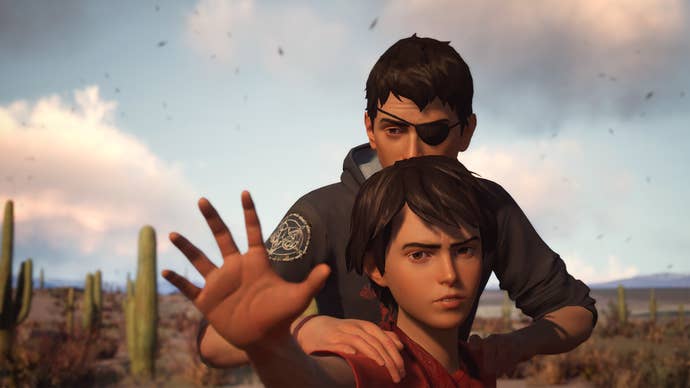
Episode One and Four of the series are its clear standouts. One establishes the formula and tugs on your heartstrings in a meaningful way, while the other breaks it apart and goes in unexpected directions. These episodes are where Life Is Strange 2 is at its best. In others, it's a series of Sean making poor decisions like he's an expendable character in a horror movie. (The last episode in particular is full of these scripted, unavoidable moments.)
The final episode also doesn't have any licensed music, which while I complained about the choice of licensed music in an earlier episode, the original score itself often fades into the background. All of its many endings (there are four major endings, with a few other minor differences depending on certain choices as well) are purely soundtracked by this background music. Because of it, the endings lack the punch they could have had.
By its end, it's an adventure that doesn't really justify the Life Is Strange billing, outside of a couple bizarre, out-of-place callbacks. Still, I was glad I saw Sean and Daniel's story through, and after watching the other endings on YouTube, I'm satisfied with the ending I personally got. The bumps along the way may have not always been engaging—even the final episode has a tedious, hour-plus-long start until it really gets going—but even through all that, I connected to the Diaz brothers. I wanted them to be happy, whether that was in Mexico or somewhere else.
ConclusionLife Is Strange 2 has a better core relationship at the heart of its game, but it fails them with the episodic adventure's at times boring, formulaic episode structure; something its predecessor did not suffer from. Some of the story beats are preachy and unearned. Where Life Is Strange 2 hits its stride is more a technical feat: in how its core relationship between brothers Sean and Daniel becomes a game mechanic in itself, and how all the choices you make shape Daniel as he grows up.
